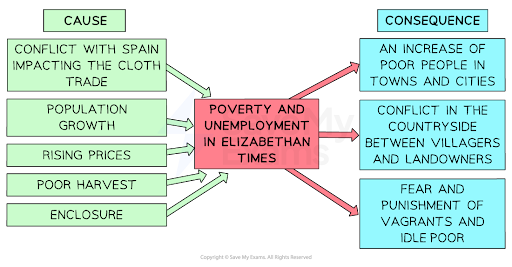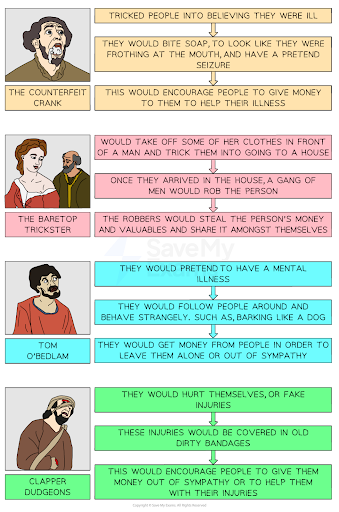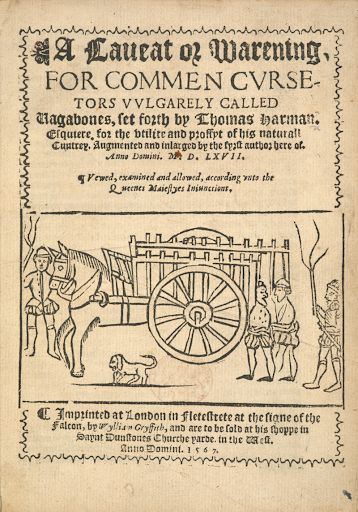Poverty in Elizabethan Times (WJEC Eduqas GCSE History): Revision Note
Exam code: C100
Why was poverty an issue in the Tudor period? - Summary
Poverty was an issue throughout the Tudor period. The monarchs of this time all contributed to the problem in different ways. For example, both Henry VII and Henry VIII contributed to unemployment. Henry VII focused on the threat of rebellions and sought to contain it. Therefore, he limited the right of nobles to have armies, which created unemployment. When Henry VIII dissolved the monasteries, this resulted in the loss of employment and eviction for anyone working there.
Throughout the Tudor period, the country experienced economic hardships and high taxes. Henry VIII's wars with France created taxes, and debasement during Edward VI’s reign hurt trade and jobs. This resulted in the collapse of the cloth trade.
When Elizabeth came into power, there was mass unemployment, and the economy was weak. Other factors throughout her reign, such as poor harvests, made poverty worse in England.
The Classification of the Poor in Elizabethan Times
The Tudor government classified the two into two categories:
The ‘impotent poor’
Those unable to work due to a disability or illness
They were given poor relief
The ‘able-bodied poor’
Those able to work but were unable or unwilling to find a job
Causes of Poverty in Elizabethan Times
Poverty became worse during Elizabeth’s reign
Charitable systems were unable to keep up with demand for help
Unlike the monarchs before Elizabeth, the increase in poverty during her reign was not necessarily caused by her actions
Poor harvests between 1594 and 1598 resulted in:
Food shortages
Death from starvation
The introduction of a new farming system called enclosure meant that:
Less land was used for growing crops
Fewer workers were needed
The population of England increased
The population in England grew from 2.8 million to 4 million during Elizabeth’s reign
Inflation was high
Poor harvests resulted in food prices increasing
There was an outbreak of flu in 1556
The epidemic killed approximately 200,000
It reduced the number of workers growing food

Unemployment & Vagrancy in Elizabethan Times
As unemployment and economic issues increased, so did homelessness and vagrancy
Many people in Elizabethan society disliked these vagrants
They blamed them for the increase in crime during this period
Many Elizabethans believed that the poor were
Lazy
The cause of increasing taxes to pay for poor relief
Spreading diseases
More likely to rebel
Willing to turn to a life of crime
Vagrancy
In 1566, Thomas Harman published a book called A Caveat or Warning for Common Cursitors
It identified 23 different types of vagabonds, including:
The Counterfeit crank
The Baretop Trickster
Tom O’Bedlam
The Clapper Dudgeons

Many wealthy Elizabethans started to help the deserving poor by creating:
Almshouses
Charities
Orphanages
For example, St Thomas’ Hospital in London opened an orphanage
Taxes on the wealthy
In cities such as Norwich and Ipswich
Examiner Tips and Tricks
In this exam, question 3 will ask you to explain the significance of the event, person, or factor mentioned in the question. For example, the question might ask, “Why was vagrancy seen as a significant threat to law and order during the reign of Elizabeth I?”
To answer this question successfully, you must focus on explaining the significance of the factor rather than listing or describing it.
Government Legislation
Previous Tudor monarchs attempted to deal with the poor through punishments
In 1496, Henry VIII placed beggars in stocks or sent them back to their hometowns
Whereas in 1531, beggars (without a licence) were whipped in public
If they were caught a second time, they would have a hole burned in their ear
If caught a third time, they were hanged
At the start of Elizabeth’s reign, the punishments of 1531 were still enforced
However, Elizabeth’s government started to accept responsibility for the poor
The fear of social unrest and rebellion forced the Elizabethan government to act
They saw a difference between the ‘deserving’ and ‘undeserving’ poor
Eventually, assisting the ‘undeserving’ poor through poor relief and helping the ‘deserving’ poor to find a job
Elizabethan Poor Laws
Between the years 1563 and 1601, the Elizabethan government introduced a series of acts of parliament (laws) which became known as the Poor Laws
They included a nationwide compulsory system to reduce The Statute of Artificers, 1563
The act
Ensured all Elizabethans contributed to poor relief
Provided all boys with a seven-year apprenticeship in a trade or craft
Set a maximum wage limit
It attempted to reduce vagrancy by
Creating employment
Tie men down to one area
The Vagabonds Act, 1572
The act
Gave penalties against vagrants
Provided shelter for the old and sick
Forced local people to pay a poor rate
Registered the poor with Justices of the Peace (JPs)
Appointed an overseer to help JPs
It attempted to reduce vagrancy by
Giving harsh punishments such as whipping and the death penalty to deter vagrancy
However, the Act did nothing to remove the causes of poverty
The Act for the Relief of the Poor, 1576
The act
Made JPs keep materials in local areas for people to find a job
Placed those who refused to work in a House of Correction
Forced JPs to create two Houses of Correction in each county
It reduced vagrancy by
Providing work to able-bodied vagrants
Punished those who refused to work
However, the act did nothing to remove the causes of poverty
The Act for the Relief of the Poor, 1598
The act
Appointed four overseers to each parish
Gave the overseer the responsibility of collecting and administering the poor relief
Taught poor children a craft or trade
Introduced a compulsory poor rate, which was to be paid by everyone
It attempted to reduce vagrancy by
Attempting to provide jobs
The act remained a law until 1834
However, it did not support those in need of help
The Act for the Punishment of Rogues, 1598
The act
Made JPs create a House of Corrections for rogues and vagabonds
Forbade anyone from begging
It attempted to help poverty and vagrancy by
Containing the problems
Reducing the risk of social unrest
The Act for the Relief of the Poor
The act
Made the 1598 Poor Law permanent
This showed a change in attitudes as the government realised that it had a responsibility to help the poor
This provided a legal framework to end poverty
How successful were the Poor Laws?
The Elizabethan poor laws had a mixed success rate
The poor laws were successful as they
Helped thousands in need of support
Provided trade and craft opportunities to children
Saw a change in the attitudes towards the poor
Prevented rebellions and social unrest
Created a system that was enforced for 200 years
However, they were also unsuccessful as
Poverty continued to rise
They failed to address the cause of poverty
Worked Example
What can be learnt from Sources A and B about the poor in Elizabethan times?
Source A
“I say that the large number of idle, wandering people and robbers of the land are the chief cause of the food shortage, for they do not work but lie idly in ale-houses day and night eating and drinking excessively … and when they are put in jail, the poor country people they have robbed are forced to feed them.”
[An extract from a letter written to Lord Burghley on September 1597 from a Justice of the Peace in Somerset.]
Source B

[4 marks]
Answer:
The sources show that many poor people in Elizabethan England were seen as a problem and were treated with suspicion. Source A shows that large numbers of poor people were being described as ‘idle’ and ‘wandering’, suggesting that they did not have regular work or places to live (1). It also shows that they were being blamed for crime in Elizabethan times, including robbery (1). Source B shows that books were written about the poor, such as A Caveat or Warning for Common Cursitors, to inform people about the poor in Elizabethan society (1). It also shows that the poor were labelled as ‘cursitors’ or vagabonds, suggesting that they were viewed as dishonest and potentially dangerous people (1).
Examiner Tips and Tricks
When writing your answer to question 1, remember that you must use both source A and B equally. Any imbalance will prevent you from being awarded full marks for this question.

Unlock more, it's free!
Did this page help you?